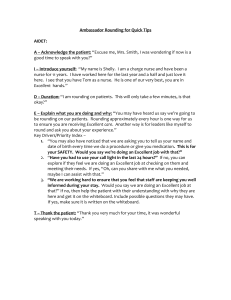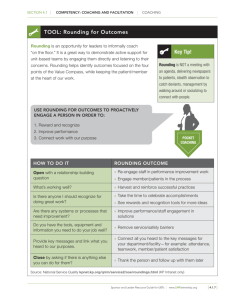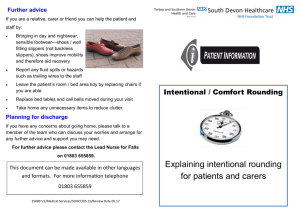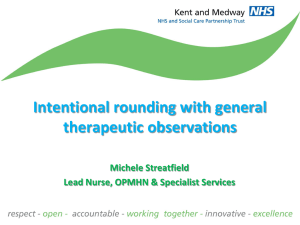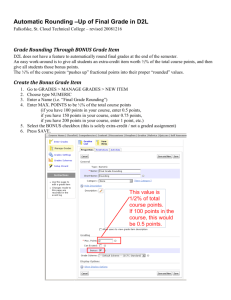Leadership Rounding
advertisement
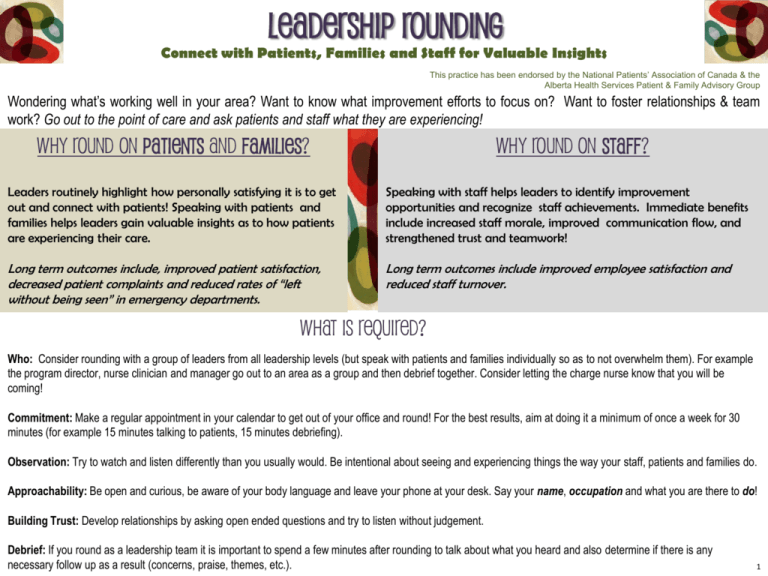
Leadership Rounding Connect with Patients, Families and Staff for Valuable Insights This practice has been endorsed by the National Patients’ Association of Canada & the Alberta Health Services Patient & Family Advisory Group Wondering what’s working well in your area? Want to know what improvement efforts to focus on? Want to foster relationships & team work? Go out to the point of care and ask patients and staff what they are experiencing! WHY Round on Patients and Families? WHY Round on Staff? Leaders routinely highlight how personally satisfying it is to get out and connect with patients! Speaking with patients and families helps leaders gain valuable insights as to how patients are experiencing their care. Speaking with staff helps leaders to identify improvement opportunities and recognize staff achievements. Immediate benefits include increased staff morale, improved communication flow, and strengthened trust and teamwork! Long term outcomes include, improved patient satisfaction, decreased patient complaints and reduced rates of “left without being seen” in emergency departments. Long term outcomes include improved employee satisfaction and reduced staff turnover. WHAT Is required? Who: Consider rounding with a group of leaders from all leadership levels (but speak with patients and families individually so as to not overwhelm them). For example the program director, nurse clinician and manager go out to an area as a group and then debrief together. Consider letting the charge nurse know that you will be coming! Commitment: Make a regular appointment in your calendar to get out of your office and round! For the best results, aim at doing it a minimum of once a week for 30 minutes (for example 15 minutes talking to patients, 15 minutes debriefing). Observation: Try to watch and listen differently than you usually would. Be intentional about seeing and experiencing things the way your staff, patients and families do. Approachability: Be open and curious, be aware of your body language and leave your phone at your desk. Say your name, occupation and what you are there to do! Building Trust: Develop relationships by asking open ended questions and try to listen without judgement. Debrief: If you round as a leadership team it is important to spend a few minutes after rounding to talk about what you heard and also determine if there is any necessary follow up as a result (concerns, praise, themes, etc.). 1 How to Round on Patients, Families and Staff Questions to Ask Patients and Families: • • • • • • • ‘How are we doing with caring for you today?’ ‘Tell me about your experience of being admitted?’ (i.e. from the ER) ‘Are you feeling prepared for your ____?’ (discharge, surgery, transition to another unit etc.) ‘Is there anything that we could be doing better from your point of view?’ ‘Are we involving your family in the ways you would like us to?’ ‘Are the staff giving you the information you need?’ ‘Is there something else you would like me to know?’ Questions to Ask Staff: (Tip: Speak with staff and physicians immediately after speaking with patients to relay any immediate feedback) • • • • • ‘What's working well today?’ ‘Are there any individuals I should be recognizing?’ ‘Do you have the tools and equipment you need to do your job today?’ ‘Is there anything we, the leaders, could do better?’ ‘Is there something else you would like me to know?’ This Practical Wisdom Adapted from: De Hart, D. (2005). Hardwiring excellence: Purpose, worthwhile work, making a difference. Fire Starter Publishing. Retrieved from https://www.studergroup.com/dotCMS/knowledgeAssetDetail?inode=111088 Institute for Healthcare Improvement.(2011). Pursuing perfection: Report from Mcleod regional medical center on leadership patient rounds. Retrieved from http://www.ihi.org/knowledge/Pages/ImprovementStories/PursuingPerfectionReportfromMcLeodRegionalMedicalCenteronLeadershipPatientRounds.aspx Lindsey, S., & Corkman, B. (2012). 4 keys to effective administrative rounding. Retrieved from http://www.beckershospitalreview.com/hospital-management-administration/4-keys-to-effective-administrative-rounding.html patient.engagement@albertahealthservices.ca Vlachos, M. (n.d.). Purposeful rounding. Retrieved from http://bhclg.com/rounding

